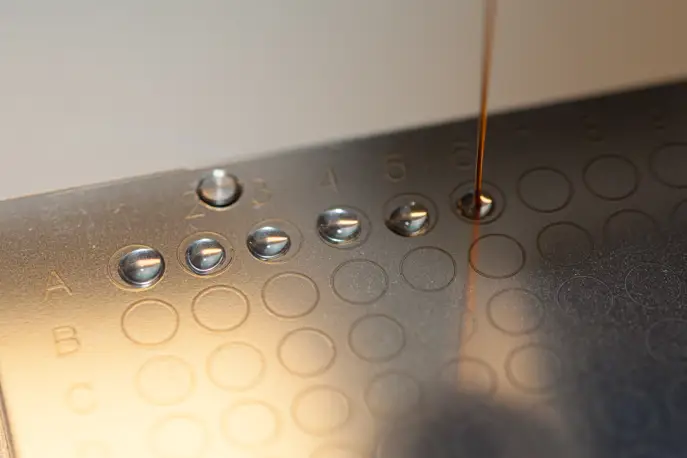1. A target plate is placed into the ionisation chamber of the mass spectrometer. Spots to be analysed are shot by an ultraviolet N2 laser desorbing microbial and matrix molecules from the target plate. Since most of the energy is absorbed by the matrix, this converts it to an ionised state.
2. Through random collision in the gas phase, charge is transferred from matrix to microbial molecules
3. The generated cloud of ionised molecules is funnelled through a positively charged electrostatic field into the time-of-flight mass analyser, a tube under vacuum.
4. The ions travel toward an ion detector with small analytes travelling fastest. This is followed by progressively larger analytes
5. As ions emerge from the mass analyser, they collide with an ion detector, generating a mass spectrum representing the number of ions hitting the detector over time. Although separation is by a mass-to-charge ratio, as the charge is typically single for the described application, separation is effectively by molecular weight
Application
MALDI-TOF can be used to analyse the protein composition of a microbial cell. In recent years, this has become the leading technology for microbial species identification. The system scans for microbial proteins that primarily fall within the range of 4000 to 20,000 Daltons (60% to 70% of the dry cell weight of bacteria) 6.
Advantages
Strengths of the technology include reproducibility, speed and sensitivity of analysis.
With results available within minutes to just a few hours (rather than a wait of several days), speed is a great advantage. The simplicity of sample preparation and result acquisition also rank this method highly.
A further advantage is that, in most instances, only a single colony is required to perform the test (excluding yeasts and mucoid colonies).
Improving accuracy
For any identification system to remain current, it is important that its database is updated regularly to allow for changing nomenclature in relation to new or reclassified species. It is important for users to have the capability to add local mass spectral entries. This is so existing databases can be improved.
Another point to consider is testing organisms in duplicate. Many microbiologists recommend testing all isolates in duplicate to help minimise invariably. In the case of MALDI-TOF, when deploying two spots one should have a better inoculum providing a better log score (that is, the probability of a correct identification).
Regular verification is also important. It is recommended that the performance of the extraction step and of the challenging of the MALDI-TOF mass spectrometer be conducted. The optimal way to do this is through the use of selected bacterial control strains (where reproducible spectra will previously have been generated and held within the system database) 7.
Disadvantages
The primary operating concern with a MALDI-TOF system is spectral interference. Some organisms are more prone to this than others, with those in the endospore state being the most at risk.
Failure to identify some organisms can also arise due to the growth media used, with the components of some media resulting in potential interference.
The completeness of an identification depends upon the level required by the user. With mass spectrometry spectra it is not always possible to differentiate similar or closely related organisms such as Escherichia coli and the Shigella species. A similar issue can arise between members of the Streptococci and Pneumococci. Moreover, some organisms are prone to misidentification, especially those that possess capsules. This prevents efficient lysis of cells and results in a weak extraction yield and poor spectral quality 8.
As with any microbial identification system, the appropriateness of MALDI-based identification systems is dependent upon how comprehensive the databases are. In addition, the system is relatively expensive, hence the laboratory must balance the throughput of samples against the initial capital outlay.
The number of currently available commercial platforms is limited. Since each commercial manufacturer uses their own algorithms, databases, software and interpretive criteria for microbial identification, the numerical data generated (in the form of spectral scores) cannot be readily compared between different commercial systems. This restricts the exchange of scientific information.


